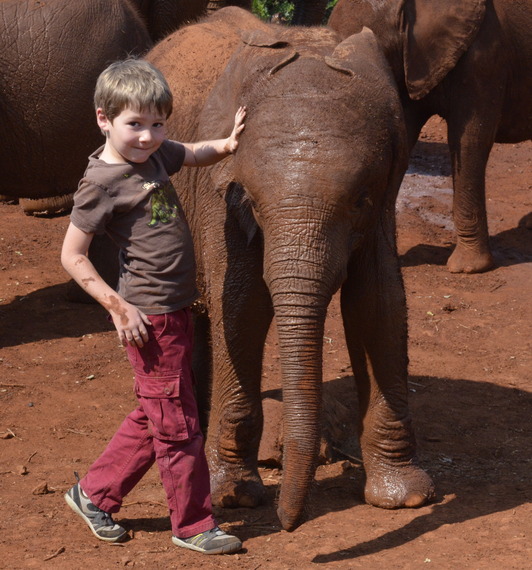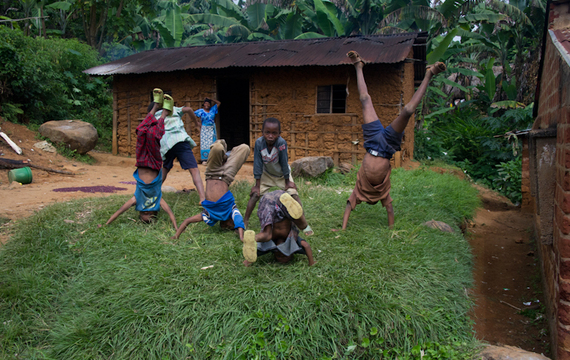I recently took my son to the David Sheldrick Wildlife Center in Nairobi, Kenya. Suffice to say, they do amazing work rescuing and rereleasing baby elephants and rhinos back into the wild. They currently house 29 elephants under the age of three and one five-year-old who has a broken leg thanks to a trap she fell in. The Sheldrick Center is an interesting place because it allows you to bear witness to the magnificence of elephants by observing only the most vulnerable of the species, orphaned babies, some of which are not more than a month old. When you see an elephant baby up close and personal, I challenge you to not fall fiercely in love. They frolic; they get stunningly, blissfully dirty; they console each other and they reach out to you for comfort. I found myself uttering to no one in particular, "How can we live in a world where our grandchildren may not know the grandeur of elephants roaming through the savanna?" And by uttering these words, I fell into my own trap, the trap that we set for ourselves time and time again: "We owe it to future generations to protect..."
The environmental movement, of which I am part, has long relied on the crutch of protecting the environment "for future generations." While it is a valid and important reason to invest time, money and energy into natural resource management, there is a much more compelling and urgent motive for protecting the environment, and all of the majestic species and vital ecosystems that are contained therein: current generations. The future, for billions of people, is a luxury. Today matters, tomorrow matters and the path from today to tomorrow is uncertain for so many people, especially for the 60 percent of the world's poor that rely on natural resources for survival, most of whom are women and children. As their environment collapses, their day to day existence becomes less certain.
As the environment becomes degraded due to things like deforestation, destructive fishing practices and pollution, impacts on people's lives and livelihoods mount. For example, forests protect soils. When trees are cut down the top layer of earth, that is vital for growing food, is washed away by rain or blown away by the wind. Yes, this undermines important habitat for beloved and necessary species such as impressive gorillas and spectacular birds, but it also translates into food shortages that cause malnutrition in children and jeopardize maternal health. When children are hungry and mothers are dying, people turn to acts of desperation including the slashing and burning of more forests. This cycle is in no way sustainable, but it puts food on the table today. Similarly, water is increasingly hard to find and when it is found it is often contaminated. Rivers carry pesticides, silt and sand and human waste downstream and when the river meets the sea, dead zones erupt wherein no plants or animals survive. But contaminated water is also killing children and is, in fact, the second most common cause of death in children under the age of five.
The collapse of food and water supplies is driven not only by local actions but also by changing climactic conditions. And let's be clear, the term "changing climactic conditions" is not a futuristic sci-fi fantasy buzzword. It is a here and now reality for billions of people. Right now I am sitting in the middle of Kenya's rainy season and, simply put, there is no rain. When the dry season comes, there is often flooding. Seeds do not grow where they have always grown and farming practices that have always worked do not work anymore. Food and water shortages grow longer, less predictable and more calamitous.
It is not all doom and gloom. There is a tremendous amount of opportunity and there is a growing assemblage of organizations who understand and work toward finding solutions for the interconnected problems of poverty and environmental degradation. Some of these are environmental organizations or organizations focused on the protection of species. The aforementioned David Sheldrick Wildlife Center finds and fixes baby elephants but also works with communities to grow new forests to protect food sources for children. The Jane Goodall Institute, long loved for its important work with chimpanzees, knows that supporting the human condition is mission critical.
Just as importantly, there are development organizations that were established to fight poverty and increasingly understand that in order to be successful, the environment must be safeguarded. Heifer International is a spectacular example of that. Finally, there are sustainable, thoughtful businesses that know environmental work and community empowerment are one and the same. The Maasai Wilderness Conservation Trust was formed by the folks at the beautiful, sustainable ecolodge, Campi ya Kanzi. They understand that cervical cancer screenings and new primary school classrooms are necessary right alongside anti-poaching and carbon credit programs.
What can you do to support these efforts? Find organizations that understand the solutions for poverty and environmental degradation are interconnected and support them with your money, your time, your effort. Future generations matter. Long-term sustainability matters. But we will not win the long game if we do not recognize that protecting the lives of children today matters more. It makes us better people. It makes us better environmentalists.


